Snackwave: A Comprehensive Guide To The Internet’s Saltiest Meme
by Hazel Cills and Gabrielle Noone
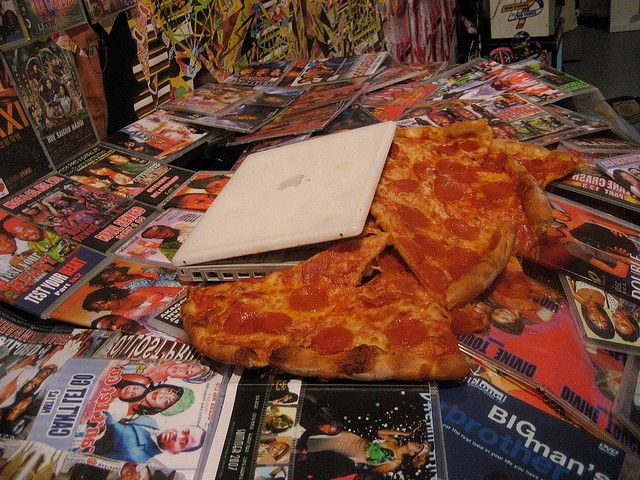
Over the past few years, an aesthetic we like to call “snackwave” has trickled up from Tumblr dashboards. Now a part of mainstream culture, snackwave is everywhere: it’s printed on American Apparel clothes and seen in Katy Perry music videos. It’s the antithesis to kale-ridden health food culture and the rise of Pinterest-worthy twee cupcake recipes. It’s the wording in your Instagram handle, a playful cheeseburger selfie, Jennifer Lawrence announcing on the red carpet that she’s hungry for a pizza. In snackwave world, everyone is Claudia Kishi, and your junk food drawer is also your blog.
What we’ve written here is merely a guide to understanding the rise of this very Internet 3.0-specific aesthetic. Snackwave is no longer a lowbrow joke bonding tweens across Twitter feeds and Tumblr blogs. It’s being co-opted by corporate Twitter accounts and fashion companies, both of whom are seeking to talk just like their ‘net-savvy young consumers.
Both of us are very much a part of this scene — in fact, we’ve got McDonald’s Sweet ‘n Sour sauce IVs hooked up to our veins right now. We know snackwave inside and out. So grab a bag of Funyuns, a sleeve of Oreos, and get ready to ride the snackwave.

Defining Snackwave
So, WTF are we even talking about? In brief: snackwave is a term we’ve coined to describe the current Internet phenomenon of young women and teenage girls expressing an obsession with snack foods.
When we say snack foods, we mean:
- Burgers, grilled cheese, ramen, burritos, pizza (the latter being, arguably, the most important beloved Internet snack food. Yes, these items technically qualify as meals, but in snackwave anything can be a snack when eaten alone in front of the computer.)
- All brands of fast food, from Taco Bell to McDonalds
- Microwavable snacks such as Bagel Bites, Hot Pockets, and Totino’s Pizza Rolls
- Food found on the delectable menus of Red Lobster, TGI Fridays, Ruby Tuesdays, and other similar restaurants. Caveat: it’s much more likely for a snackwave girl to make jokes about these restaurants (i.e. a tweet that says “Buy me endless soup, salad, and breadsticks, so I know it’s real) rather than actually eat at one.

Girls take these foods and incorporate them into their internet presences. The most apparent usag is found on the numerous Twitter handles that fall under the following formula:
[food] + [slut/bitch/babe/girl/queen/witch]
The “snackwave voice” is typically female, young, probably suburban, highly cynical, totally awesome, absolutely brilliant, definitely us, yeah, uh, we’re talking about us right now. The snackwave voice alters between immensely confident and self-deprecating. The latter is why a Twitter account like @SoSadToday is so popular.
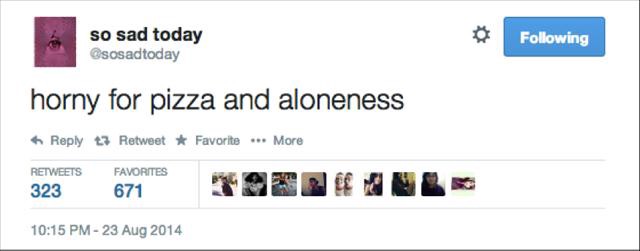
Consuming foods that are (by all standards) bad for you heightens the #doomed nature of the tweet. Humanity is doomed to begin with, and since we all DIE SOMEDAY, why not live in these sad sacks of flesh with as many french fries in our mouths as possible?
It’s important to note that snackwave is different from, say, a bunch of girls eating snacks and tweeting about them. Snackwave is defined by exaggeration and extremism. You don’t just eat cheeseburgers. You wear a shirt covered in them. You don’t just eat pizza. You run a blog devoted to collecting pictures of celebrities eating pizza. In a world of Women Laughing Alone With Salad, snackwave is our saviour.
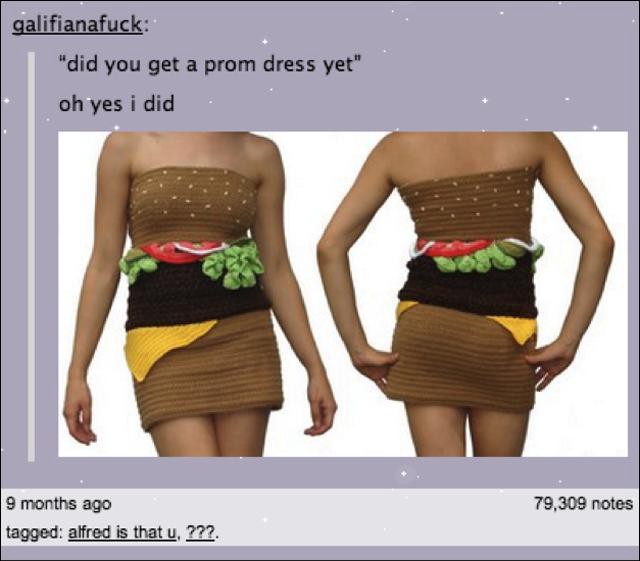
Your cheeseburger prom dress, whether hypothetical or not, will garner up to 79,000 notes on Tumblr!

The Roots of Snackwave
A clear timeline tracing the rise and acceptance of snackwave is difficult to ascertain. Perhaps, by divine intervention, a young woman once found herself in the possession of a fistful of Burger King Chicken Fries and decided to publish her joy to the Internet; it’s impossible to say.
There are, however, a significant number of early to mid-2000s pop cultural artifacts that have certainly inspired snackwave.
1. Pop Culture
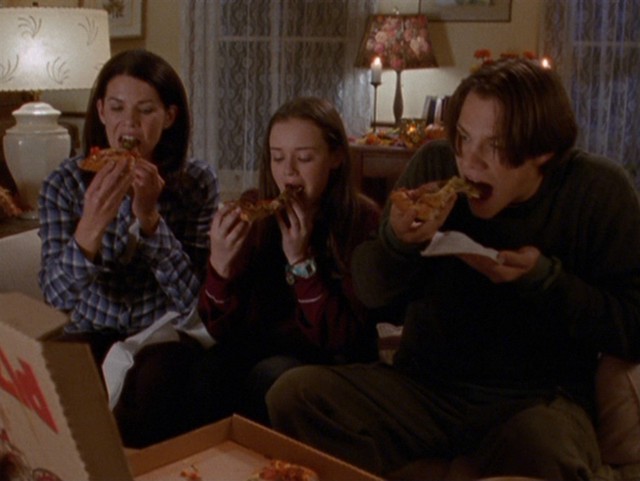
For example: Rory Gilmore. The protagonist of the 2000–2007 sitcom Gilmore Girls, Rory was a studious, witty, adorable and outspoken teenage girl. Rory, along with her BFF/mom Lorelai, ate a diet consistently almost exclusively of junk food and coffee. In an early episode, Rory’s boyfriend Dean arrives at the house bearing a pizza and a bag of salad, to the horror of Rory and Lorelai.
RORY: What’s in there? [pointing to a bag]
DEAN: Uh, a salad.
RORY: A salad?
DEAN: Yeah, it’s a quaint dish sometimes used to proceed large quantities of pizza.
[Rory and Lorelai look at him]
DEAN: It’s…for me.
RORY: Clearly.
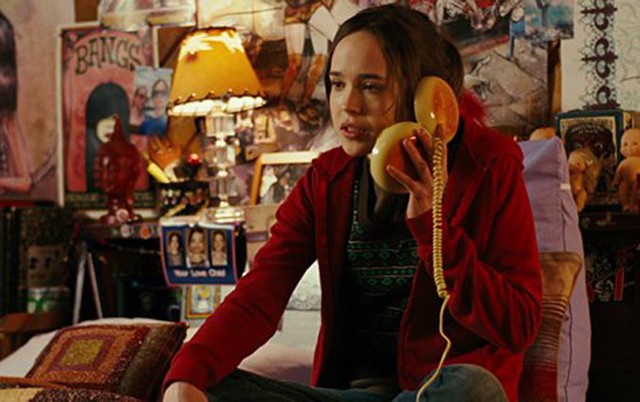
Around the same time, fast food imagery began to subtly manifest itself into various aspects of indie culture. In 2007, the film Juno won the Best Screenplay Oscar. Between the combination of the protagonist’s sardonic, observational humor about suburbia to her diet of convenience store favorites like Sunny-D, blue Slushees, and her hamburger-shaped telephone, Juno was the ultimate snackwave pioneer. Juno was released right as the 16–22 year-old girls of today’s Internet were beginning to enter teenagehood. For these girls, lines such as “He’s the cheese to my macaroni” and “honest to blog” were preeminent tweets.
The same year Juno came out, the Cali-based indie rock label Burger Records launched. An era of lo-fi, Cali-based slacker surf rock was just dawning and it often contained snackwave signifiers. Singers like Cassie Ramone and Katy Goodman of Vivian Girls donned cheeseburger and milkshake tattoos.
In 2009, Best Coast released the music video for “When I’m With You,” featuring Bethany Cosentino in a relationship with the McDonald’s mascot, Ronald McDonald.
Liz Lemon, the protagonist of Tina Fey’s show 30 Rock and played by Fey herself, is another important figure in the rise of snackwave. Lemon is, according to her Republican boss Jack Donaghy (played by Alec Baldwin), a “New York third-wave feminist, college-educated, single and pretending to be happy about it, over-scheduled, undersexed. You buy any magazine that says ‘healthy body image’ on the cover and every two years you take up knitting for… a week.”
She’s smart, cynical, and supposedely “undateable”, despite the fact that Lemon dates men portrayed by such notable Hollywood handsome men as Jon Hamm and James Marsden. Her “undateability” is most often depicted through her love of terrible snacks. Lemon is the type of woman who will literally flip a table when her macaroni and cheese order doesn’t arrive at the office. She’ll shotgun an entire pizza. In an early episode, Lemon and her friend Jenna Maroney are at a bar. Jenna tells her a man wants to buy Lemon a drink and she responds, “Really? I already have a drink. Do you think he’d buy me mozzarella sticks? And who could forget Liz Lemon’s ode to “Night Cheese?”
But Lemon doesn’t really wallow in her single status. She’s a savvy and hilarious boss leading a team of childish men as best she can. Lemon symbolizes a character who lives the snackwave life from a place of celebration rather than defeat. She takes the Bridget Jones-esque “single girl crying over ice cream” cliché, embraces it fully, and takes the concept to the most absurd conclusion. In one episode, Liz Lemon is drawn to buy an apartment that “smells like Burger King all day and Cinnabon all night.” In another, Lemon is obsessed with a cheese-puff chip called “Sabor de Soledad” (which translates to “The Taste of Loneliness”) — a product that turns out to be made with bull semen. She continues eating them anyway. In Lemon’s world, binge-eating pizza and macaroni cheese on a Saturday night isn’t sad, it’s actually funny and cool.
2. Health Food Mania
Snackwave may have originated as an opposition to health food culture. Are young people really eating more fast food? That doesn’t particularly matter to the snackwave aesthetic. Organic farming, kale salads, and whatever other artisanal green shit young people like are often considered standard fare for millennials. Grease-laden microwavables and fast food are the quirkier go-to choice. Snackwave will not fuck with your Mason jar of pickled veggies.
3. Women Not Giving A Damn
Health food culture is often a thinly disguised way of policing women’s bodies. Rather than celebrate not eating at all, health food culture suggests that women embrace a #yesfilter view of salads and yogurt; staying thin and taking to their social media to express their enthusiasm over their choices.
In a way, snackwave is a protest against this mindset. Snackwave is about taking pleasure in foods that are deemed off-limits for women who want to stay thin and traditionally attractive. Food becomes cartoonish and goofy, rather than a constant test of whether or not you’re treating your body the way the world (i.e. menz) wants you too.
Snackwave is, however, frequently tied to images of traditionally thin women. Liz Lemon, Rory Gilmore, Juno; these are all skinny white women, women who are not indulging in the all-cheese, all-carb diet they promote as the characters they play.
We would posit that snackwave, as a voice, is present in the social media accounts of women of different body types, but that eating junk food only becomes “cool” when the women doing so look like Mila Kunis or Jennifer Lawrence. For example: the Instagram account You Did Not Eat That, exists soley to post pictures of cute, thin girls posing with food they apparently didn’t — or couldn’t — have eaten. The account aims to be a call-out for using pretty food as props, but it also propagates assumptions about young women and often veers into sexist food-shaming.
Snackwave can also be linked to the concept of the “Cool Girl,” notably described by a character in Gillian Flynn’s novel Gone Girl. “I’d want to grab the poor guy by his lapels or messenger bag and say: The bitch doesn’t really love chili dogs that much — no one loves chili dogs that much!” Amy says.
Snackwave responds with a simple question: well, what if they do like chili dogs that much? And, more importantly, why is the knee-jerk reaction to a girl taking a selfie with a cheeseburger is that she’s faking it?
The collective indulgence in junk food, when added up, becomes less about being an outsider/”cool” diet and more about reflecting an existing attitude amongst a particular group of women. It’s most prominently seen as an aesthetic filter for self-deprecation (i.e., we’re “sad girls,” but we’ve got nachos so it doesn’t matter), both a joke and a coping mechanism.
Within our definition, snackwave is certainly not a bunch of women eating like dudes to either impress dudes or distance themselves from other girls. Snackwave is the rejection of the notion that ONLY dudes eat these foods, that women ONLY eat leafy greens. Snackwave doesn’t reject the salad to appeal to men or because it’s holier than greens; snackwave rejects the salad because splitting a pizza with your girlfriends is, simply, more fun.

Fashionable Snackwave
1. High/Low Fashion
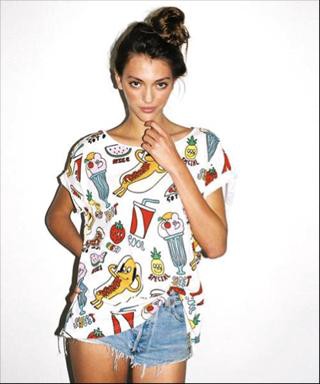
Snackwave is seeping into culture through clothing. For example: the British brand Lazy Oaf sells clothing plastered with “ironic” prints featuring popular junk foods.
Lazy Oaf, a relatively mass-market brand, has no doubt taken cues from its’ high-fashion cousin, Jeremy Scott. Scott has long been a leading designer in kitsch apparel; those familiar with his brand will recognize his penchant for clothing that appropriates mainstream labels and food culture. His Fall/Winter 2006 collection, Food Fight, was imperative to the rise of fashion snackwave. The runway show showcased sweaters dresses resembling chocolate bar wrappers, sweaters that looked like burgers, and flowing gowns in a pizza print.
Although Scott’s collection was nearly eight years ago, he predicted a clothing trend that would officially go mainstream in 2014. Moschino would take the look one step further — the Fall/Winter 2015 was a homage on McDonald’s branding, as well as other candy and cereal brands. One purse from the collection, designed to look like a fountain drink from McDonald’s, is currently retailing for $895. In a review of the collection, Hadley Freeman at The Guardian called the collection “comfort fashion…it prompts a delightful fizz of sentimentality sizzled through with wit.”
You can buy a “Bitches Love Pizza” shot glass at Urban Outfitters and a “Take A Pizza My Heart” shirt at Topshop. Forever21 sells a pajama top that reads “Some of My Best Friends Are Snacks.” The accompanying copy:
Try to meet someone who doesn’t love to snack… not possible! With this PJ set, we own our love of snacking with the cheeky “some of my closest friends are snacks” script print tank. The matching elasticized drawstring shorts show our best friends floating around all yummy- pizza, soda, hot dogs; let’s make everyday cheat day.
2. Do It Yourself

Snackwave-inspired clothing is most prevalent on Etsy. All over the DIY e-commerce site, young women are sewing, printing, selling, and buying their own snackwave apparel. Above: a sample of the 696 results when you search “pizza shirt.”
3. Celebrity Style
In recent months, multiple celebrities have been photographed wearing particularly snack-y ensembles. Katy Perry and Cara Delevigne were photographed wearing pizza-printed onesies. And who could forget when Beyonce wore a head-to-toe pizza-inspired outfit?
Which brings us to our next snackwave territory…

Celebrity and Corporate Snackwave
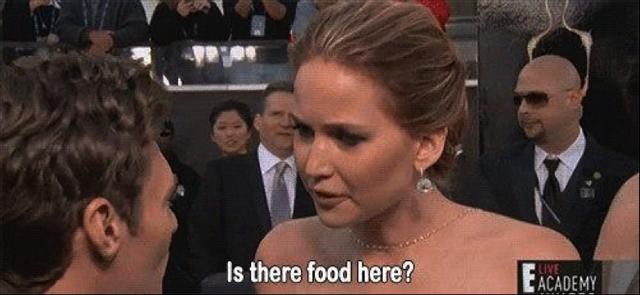
Why does the Internet love when Jennifer Lawrence talks about loving pizza? Why did the Internet SWOON when Drake took Nicki Minaj to buy all the snacks she wanted at a convenience store? Simple: there’s something delightfully relatable about Minaj opting for Cheez-Its, about Lawrence asking for pizza in her stomach during a red-carpet event (also because every girl wants Drake to be their boyfriend, but that’s a whole other Hairpin article).
In a Rolling Stone interview, Katy Perry said she looks to Tumblr for style inspiration. She’s no doubt taken a few cues from the platform’s love of snackwave, in both her outfits and her professional imagery. Katy Perry’s entire tour wardrobe is modelled after high-fructose sweets; she incorporated giant balloons of tacos, french fries, and ice cream into both the music video and her tour performance for “This Is How We Do.”

Elsewhere, America’s kewl-girl sweetheart Miley Cyrus rode a giant hot dog over the crowd during her Bangers tour. Because, you know, you gotta get from one place to the other somehow, right? Phallic AND on trend!
Celebrities aren’t the only ones getting increasingly snackwave in style and performance. Snackfood empires have embraced this trend hard. There are definitely, like, dudes in suits, pacing around inside skyscrapers trying to figure out how to engage with these SLCGOTW (Snack-Loving Cute Girls Of the Web). Okay, we’ve (maybe) never worked at a major corporation before, but you get what we’re saying.
Take, for example, the Twitter relationship between Taco Bell and Tumblr celebrity/snackwave pioneer, Molly Soda. If her pop-referencing pseudonym says anything (the blogger and artist’s real name is actually Amalia Soto,) Soda is a representation of a very popular Tumblr voice. She’s funny, she takes selfies with pizza and rats, she dyes her hair a million colors and makes mini-series about tweens built on early ‘2000s nostalgia she and all of her followers share. Her Twitter bio reads: “crying into my crunchwrap.”
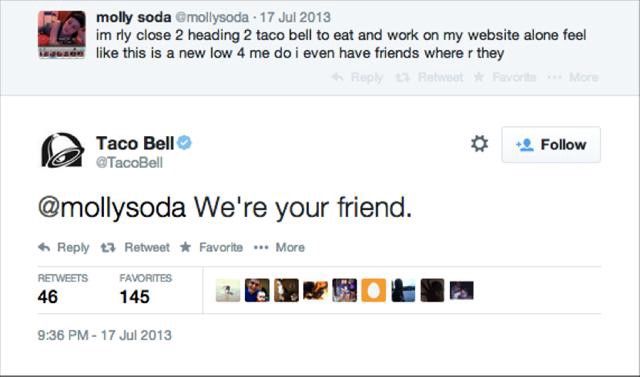
See, Taco Bell is your friend! Isn’t that cool? They’re a fast food brand that knows their audience well.
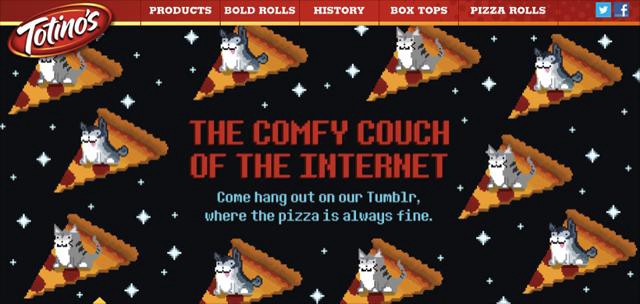
And Taco Bell isn’t alone. Totino’s curates a Tumblr account filled ironic pizza-themed imagery: Microsoft Paint .gif with a particularly Net Art-y vibe that screams “THINK ABOUT PIZZA,” a fake ad for pizza perfume, a picture of two waffles filled with pizza rolls overlaid with a “¯_(ツ)_/¯.”
Denny’s social media accounts are using a similar strategy. They get in on the trending hashtags and post tweets that seem to have nothing to do with their brand. Like Totino’s, they have a Tumblr with their own hyper-parody feed. The result is a corporate social media account that becomes strangely endearing. We were both, personally, enchanted with Denny’s commitment to nailing such a specifically weird Internet voice down.
I EAT WHAT I WANT
— Denny’s (@DennysDiner) September 5, 2014
In her article, “Weird Corporate Twitter,” Kate Losse highlighted brands like Denny’s, Hamburger Helper, and Chipotle, all of which use similar tactics on their social media accounts, and called their strategy “the cute-voiced corporation.”
Denny’s the corporation has transformed itself through its tone into a hip, ageless kid basking in the approval of its many followers. And this may be the creepy core what makes me uncomfortable in the Denny’s voice: When brands speak anonymously and yet so intimately through the voices of unnamed social-media managers, we like them more than we can like any individual tweeter. On social media, the cute-voiced corporation is cuter than any person.
Brands are looking at Tumblrs and copying the voices and aesthetics of their teen girl owners not for fun; brands embrace snackwave because snackwave will bring in profit. Their Tumblrs and Twitter accounts don’t look like traditional advertising, but it is web content specifically made to look like the feeds you scroll by every day. And because Tumblr is the place for peak snack aesthetics, and because .GIF-able desires are so easy to create, these brands become “cool” for getting the joke.
how to college: first you pizza then you learn stuff then you pizza again
— DiGiorno Pizza (@DiGiornoPizza) September 3, 2014
The adoption of snackwave by corporations like Denny’s, Moschino, and Katy Perry represents a much larger cultural shift. Snackwave is rooted in the snarky, cynical humor previously confined to Tumblr and the young girls who essentially run the platform. When a pop star like Katy Perry uses Tumblr for aesthetic inspiration, she’s revealing the “chicken or the egg” nature of all trends. The empowered “I’d rather have a pizza than a boyfriend” sensibility that originated as escapist humor for teens is now being sold back to them as ads for cheap frozen foods and cheap fast-fashion t-shirts.
Is this the end of snackwave or just the beginning? Is it proof that the teen girls of the Internet are geniuses who should — nay, must — rule corporate America? Instead of copying us, we’re officially recommending you just hire us. We’ve got some ideas on how to upgrade your offices. They mostly include nacho cheese dispensers.
Hazel Cills is a writer and witch living in New York City. She doesn’t trust a pizza slice she can’t fold.
Gabby Noone is a writer and student majoring in The Cheesecake Factory menu. She lives in New York.
Header image courtesy of Double Happiness installation “Touch Not My Anointed,” 2008.